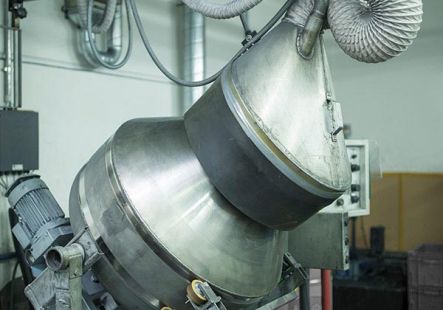Special part geometries, or geometries that are difficult to reach in the interior cannot be coated with conventional spraying methods. In such cases, we recommend the use of machinery for dip coating. In the case of dip coating, the component or substrate is dipped into the coating solution. When removing, a liquid film remains on the component. The component is then dried or cured. Dip coating is particularly economical when using wet coat, since the material loss is - in contrast to spraying (Overspray) - low. The process is used wherever the functionality of the surface is more important than the surface profile, since due to the process the tolerances must be greater.
- MnPH and ZnPH Phosphating
- PTFE Coatings
- Molybdenum disulfide coatings (MoS2)
- PFA Coatings
- FEP Coatings
- E-CTFE - Halar® coatings
- Sol-gel coatings
- Epoxy painting
- PVDF coatings
- PEEK coatings
Manganese and Zinc phosphating are chemical treatments that create a robust phosphate coating on metal surfaces, improving anchor profile, wear resistance, and chemical resistance. These coatings can be used independently or as a pre-treatment for further coating applications.
PTFE coatings, also known as Teflon®, or Xylan® , are fluoropolymer coatings renowned for their exceptional non-stick properties, high temperature resistance, and chemical inertness.
Molybdenum disulfide (MoS2) coatings are dry film lubricants known for their excellent load-carrying capacity, low friction, and high-temperature resistance.
PFA - Perfluoroalkoxy is particularly useful in high-temperature environments that demand absolute resistance and impermeability of the material. Non-stick PFA coatings excel in their high chemical resistance, non-stick, and non-toxic properties even at high temperatures.
FEP (fluorinated ethylene propylene) coating is a type of fluoropolymer coating known for its excellent non-stick properties, chemical resistance, and ability to withstand high temperatures.
E-CTFE (Halar®) coatings used as heavy-duty corrosion protection coating and chemical protection coating for your products and work pieces.
Sol-gel coating is a process that forms a solid, inorganic coating from a colloidal solution, providing enhanced surface properties like corrosion resistance, thermal stability, and optical clarity.
Epoxy coatings are designed to withstand the toughest conditions. They provide exceptional resistance to corrosion, chemicals, and extreme temperatures, making them the ideal oil and gas industry choice. From valves and fittings to critical components, our epoxy coatings enhance durability, minimize wear, and extend the lifespan of essential equipment.
PVDF (polyvinylidene difluoride) coatings are high-performance fluoropolymer coatings known for their exceptional durability, weather resistance, and protection against UV rays, commonly used on metal surfaces.
PEEK (polyether ether ketone) coatings are high-performance thermoplastic coatings known for their exceptional chemical resistance, mechanical strength, and ability to withstand high temperatures, making them ideal for demanding industrial applications.
- Automotive
- Energy
- Bakeware & food
- Semiconductor
- Chemical and pharmaceutical
- Off-shore
- Rubber & Plastics
- Textile
- General Engineering
Fluoropolymer coatings have been used in the automotive industry for many years, especially in the surface treatment of mass-produced parts to help with
Critical components in energy plants and installations are constantly exposed to harsh conditions, including corrosion, oxidation, and cavitation, leading to premature failures. Technicoat’s advanced functional coatings provide superior protection, enhancing durability and extending the service life of essential equipment. Our re-coating solutions offer a cost-effective way to restore worn components, reducing downtime and maintenance costs. With our expertise, energy facilities can operate more efficiently and reliably, even in the most demanding environments.
Fluoropolymer-based coatings are frequently used in the food industry. All coatings are FDA approved, which means they can be in direct contact with any sort of foodstuff.
Fluoropolymer coatings play a vital role in the semiconductor industry, offering exceptional chemical resistance, thermal stability, and low friction properties. These coatings are essential for protecting critical components in chemical distribution systems, wet etch and planarization processes, wafer handling and filtration, as well as tools, equipment, and electrical insulation. By enhancing durability and performance, our coatings help ensure the reliability, efficiency, and high yield of semiconductor manufacturing processes.
Fluoroplastics are used in these industries due to their chemical and thermal resistance. The coatings provide protection against solvents, acids, alkalis, oxidizing and can combine very good none-stick properties and outstanding barier and permeation resistance.
Oil and gas industry specified functional coatings and paintings since 20th century. Thin films often used on functional and precision parts, while heavy duty painting protect equipment on external surfaces.
Plastics and rubber processing industry facing adhesives and sticky compounds. Nonestick coatings facilitate efficient demoulding and avoid adhesion of sticky materials and semi-finished products onto a manufacturing and/ or handling tools and fixtures. Antifriction coatings on OEM parts improve their assembly process, increase resistance to fluids and chemicals, enable reduction of NVH.
High speeds as well as contact with varnishes, adhesives or others require effective antifriction and non-stick coatings. They serve within contact of different raw materials, reduce fiber accumulation, which increases the quality of final products and also reduces production downtime.
- Phosphating
- Blasting
- Manual Coating
- Partially and fully-automated coating
- Mass coating, tumble coating
- Dip-coating
- Powder coating and hot-flocking
- Thermal spraying
- Excalibur® Coating
Phosphating is a chemical/electro-chemical process in which thin, fine-crystalline and water insoluble phosphates are generated on metal surfaces from phosphoric acid solutions in a dipping or spraying procedure.




